
DRESSMAKING HINTS LIBRARY:
A Civil war Era Ensemble
(the 1850s & 1860s)
|
 |
| Godey’s Lady’s Book, January 1860 |
Related Pages:
|
Table of Contents
General Hints on Using and Fitting Patterns
Undergarments:
Evening Dress:
Documents, Supplies and Suppliers
|

|
General
Hints
|

|
|
Return to Top
Some basic points on using period patterns
and how to get a proper fit
Determining your Size and Tracing the Pattern
Get a friend to help you take your measurements. And be honest!
If you are using a multi-size pattern, I recommend that you use
tracing paper (I like architect’s “thumbnail” trace, available at art supply stores) to
trace a custom pattern piece in the size(s) that match your measurements most closely rather
than cutting the commercial pattern itself,
so you’ll have the original pattern to use again later, refer to if there are questions or to retrace a
new pattern piece if you have made an error. This is especially useful for multi-sized pattern where you
might want to trace a custom combination of sizes.
Cut the Muslin Mock-up
First cut your garment out of muslin, or an inexpensive fabric that behaves like your fashion fabric,
to do a first fitting before cutting any fashion fabric. Don't worry about adding any trims or
facings at this point (unless they affect the fit)
Fit the Muslin Mock-Up
Sew the pieces together, by machine, with long basting stitches (no need to back-stitch as you will probably
be ripping out and resewing seams as you alter the fit), press the seams,
put it on inside-out, pinning closed where the garment will be fastened.
Have a friend adjust the fit as needed. Garments should fit smoothly but not strain across the body.
If there are many alterations you may wish to trace a new pattern,
recut any radically altered pieces, restitch the new seamlines and then fit it again to refine the fit.
Additional hints, specific to each garment, are described below.
|
The Undergarments
The foundation of a successful period garment
is the proper set of undergarments
|
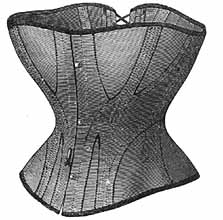
|
The
Corset
|

|
|
Return to Top
Suggested Patterns:
Choosing your Size and Tracing the Pattern
- At this point don’t worry about any facings.
Cut the muslin
- Use a firmly woven fabric or lightweight canvas
Sew and Fit the muslin
- Keep the pieces in order, they can look very similar and are easy to mix-up
- Attach a lacing strip at the center back if you have one,
or add 2 inch strips of cloth to each side of the center back
(to simulate the 2-3 inch gap present
in a properly fitted corset)
- Put it on inside out, lacing or pinning the center back closed.
- It is best to have your chemise already fitted to achieve the proper silhouette
- A bra can be worn at this point if extra support is needed.
- The corset should fit smoothly but not strain across the body.
Pay attention to the fit across the hips, if you have a large difference between your waist and hip you may need
extra ease especially at the side or rear, below the waist.
Choosing and Cutting the Fashion Fabric
- Fabrics for corsets should be firmly woven, stable, without much stretch.
- Coutil is a very good fabric for corsets, cotton drill is a less expensive alternative.
- A plain twill weave can stretch diagonally, giving you a poorly fitted final product.
- Silk satins and other finer fabrics can be used with a heavier coutil, drill or canvas type
fabric as a lining.
Points to be aware of
- If your fashion fabric is very heavy you'll need a little extra ease in the muslin,
or you may wish to use a fabric of similar weight to your fashion fabric.
- Notice where the bodice falls at the waist, if it has a pointed waist,
the sides usually stop at the waistline in the 1860s; if you wish the sides to extend below
the waistline there should be enough flare to allow for the fullness of the hoop.
Make Corset Lacing Strips
These can be basted onto the back of your corset or bodice muslin to aid in fitting the garments.
They can be reused over and over again.
- Cut 2 strips of canvas 5" by 16" fold in half lengthwise and press.
- Sew a 1/4" channel along the folded edge.
- sew a second chanel 1.5" away from the first (approx. 1" away from the raw edge).
- Insert grommets or make small button holes approximately 1" apart along the length and insert 12" bones in each channel.
Thanks to Nicole Carlson for these instructions.
|

|
The
Chemise
|

|
|
Return to Top
The most common chemise for mid 19th Century evening wear is an open necked garment
with short sleeves and a plain hem
(to be tucked into the drawers, so it gets no trimming). The short sleeves provide an
important protective layer between the underarms and the outergarment. It also helps support the bust;
the bust is generally half inside the corset and half sitting above the corset, more or less depending
on your cup size (it is best to avoid the grapefruits on a pedestal look).
Suggested Patterns:
Choosing your Size and Tracing the Pattern
- Measure around your shoulders, just below where your evening gown bodice will fall.
- The sleeves should not be longer than your ballgown sleves
Cut the muslin
- You may only want to make a muslin of the yoke to ensure a proper fit.
- Use a lightweight muslin fabric
Sew and fit the muslin
- The yoke should fall just below the line of the evening bodice and be neither too tight or too loose.
- The chemise should fit snugly across the shoulders and
Choosing and Cutting the Fashion Fabric
- A medium-weight cotton or linen, that is not scratchy is a good choice.
- Some linen fabrics can be uncomfortably scratchy once they are under your corset.
Points to be aware of
- trim is seen around the neckline, front closure and edge of the sleeves
- The hems are not trimmed in the mid-19th Century
(leading me to believe that they were tucked into the drawers).
|

|
The
Drawers
|

|
|
Return to Top
The Drawers are usually worn over the corset and chemise and button in the back
(if worn this way they can be removed, if necessary, without removing the corset).
The bottom of the chemise is tucked into the drawers for an extra amount of modesty.
There is debate in the costuming community as to the arrangement
of the undergarments. An alternate way to wear them is to put your drawers on first,
then your chemise, then your corset.
Suggested Patterns:
Choosing your Size and Tracing the Pattern
- The legs should be full enough to fit the chemise inside it.
- The crotch-depth should fit comfortably and not hang too low or be too tight.
Cut the muslin
- Skip the step of cutting a muslin unless you are overly concerned about the fit.
Choosing and Cutting the Fashion Fabric
- Medium-weight cotton and linen are good choices.
Points to be aware of
- Length should be below the knee, around or just above mid-calf.
- The hems can be decorated with tucks, gathered panels and lace or eyelette insertion and trims.
|
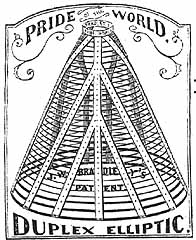
|
Hoop-Skirt
|
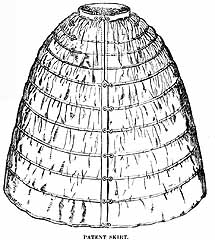
|
|
Return to Top
The Hoop skirt is what supports the bell-shaped skirt.
You can buy fairly good ready-made 6 bone hoops and adjust the width yourself.
The are patterns for hoops if you wish to make your own, either a cage hoop
or a cloth hoop-skirt with boning fed through channels in the cloth.
Suggested Patterns and kits:
Choosing your Hoop Size
- The bottom circumference will vary with the height of the wearer.
Example: at 5’ 2” tall I like to wear my hoop at 115-120” for day wear
and 130-135” for evening wear.
Adjusting store bought hoops
- Start with the bone at the hem, adjust the ends by sliding them into the casing
until the circumference is the desired size.
- You can tie it off with a rubber band for a quick and easy fastening.
- Adjust each higher bone until you achieve the desired bell shape.
|

|
Petticoats
|

|
|
Return to Top
You might want both an under petticoat to wear below your hoop-skirt, and an over-the-hoop
petticoat, with or without ruffles, to allow some extra coverage or fullness
(and light blocking layers if your skirt is sheer)
between your hoop and skirt.
Suggested Patterns:
Choosing your Size and Tracing the Pattern
- Petticoats are usually rectangles of cloth in this period.
Choosing and Cutting the Fashion Fabric
- Lightweight cotton or linen are good basic choices.
- Flounces are a way to add extra fullness.
- Flannel, white, red, or striped or quilted wool or cotton are warmer and decorative alternatives.
Points to be aware of
- Don't make the under-petticoat too long, mid-calf works well.
- Don't make the over-petticoat so long that it shows below the skirt, unless that’s the look you are
trying to achieve, such as a decorative colored petticoat under a looped up skirt.
- The hem can be trimmed with tucks, wide or narrow, lace, insertion, or if the petticoat is colored,
decorative trims.
|
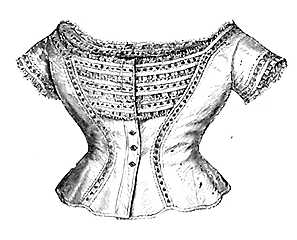
|
Corset Cover
|

|
|
Return to Top
The corset cover is not always worn. It can be worn over the corset to protect the outer garnment
from wear from the corset and to hide the undergarments under sheer bodices.
If your bodice is sheer or if extra sweat or wear-and-tear protection is wanted
you may want to add one to your outfit. This garment is fairly fitted, has short sleeves and buttons in the front.
Suggested Patterns:
Choosing your Size and Tracing the Pattern
- This garment will fit similarly to your bodice so as not to add much extra bulk.
Choosing and Cutting the Fashion Fabric
- Suggested fabrics are muslin in cotton or linen.
|

|
The
Bodice
|

|
|
Return to Top
The bodice fits smoothly wthout straining across the body or shoulders. The shoulder line is
slightly dropped and the arms cannot be raised straight up over the head. The waistline is either poined or straight.
The closure is in the
center back, with either lacing (most common) or hooks and eyes. sleeves are skort and are usually full.
The neckline trim is often called a berthe.
Suggested Patterns:
Fitting The Bodice Pattern
- The fit of the bodice is paramount.
- It is wise to start with proper measurements, have a friend help you.
Choosing your Size and Tracing the Pattern
- Make sure the shoulers fit properly, without being cut too low or too high.
- At this point don't worry about the berthe, sleeves or facings.
Cut and Sew the muslin
- Use a fabric that approximates the weight of your fashion fabric.
- Trace the the darts and pin rather than sew them as they may be altered considerably while fitting.
Fit the muslin
- It is best to have your undergarments already fitted, including a chemise,
corset, hoop (for waistline placement), and any other shaping undergarments.
- The bodice should fit smoothly but not strain across the body.
- The shoulder line should sit flat across the shoulders, without drooping or straining.
- Darts should generally be fairly close to the center front at the waist especially if the
waistline is pointed.
- If there are many alterations you may wish to
recut anything if needed, restitch the new seamlines and then fit it again to refine the fit.
Points to be aware of
- If your fashion
fabric is very heavy you’ll need a little extra ease in the muslin,
or you may wish to use a fabric of similar weight to your fashion fabric.
-
Notice where the bodice falls at the waist, if it has a pointed waist,
the sides usually stop at the waistline in the 1860s; if yu wish the sides to be
below the waistline there should be
enough flare to allow for the hoop’s fullness.
- Add a drawstring at the neck in the casing formed by the neckline piping to
obtain a neckline that doesn t gape.
|

|
The
Skirt
|
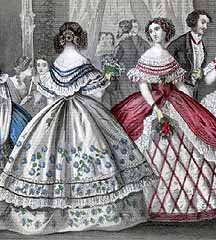
|
|
Return to Top
The easiest skirt to make is a long rectangle of widths of cloth, with a simple closure at
either side front or the back. The waistband is fairly narrow and closes with hooks and eyes.
Suggested Patterns:
Choosing your Size and Tracing the Pattern
- I find that the right length for a dancing skirt is floor length without a hoop.
- A skirt meant to be worn for dancing would be shorter than a day dress skirt.
- Fit the wait over all of the undregarments.
Cut the muslin
- A muslin shouldn’t be needed for the skirt.
Points to be aware of
- If you are using a plaid or stripe make sure the pattern lies straight along the hemline and adjust the
length at the waist where a jagged or slanted line will be less noticable.
- Notice where the bodice falls at the waist, if it has a ponted waist,
the sides usually stop at the waistline in the 1860s; if you wish the sides to be below the waistline there should be
enough flare to allow for the hoop’s fullness.
Return to Top
Return to Library Index
|
|
|
Go to:
Quick Links:






last updated 30 nov 2014/csb
|